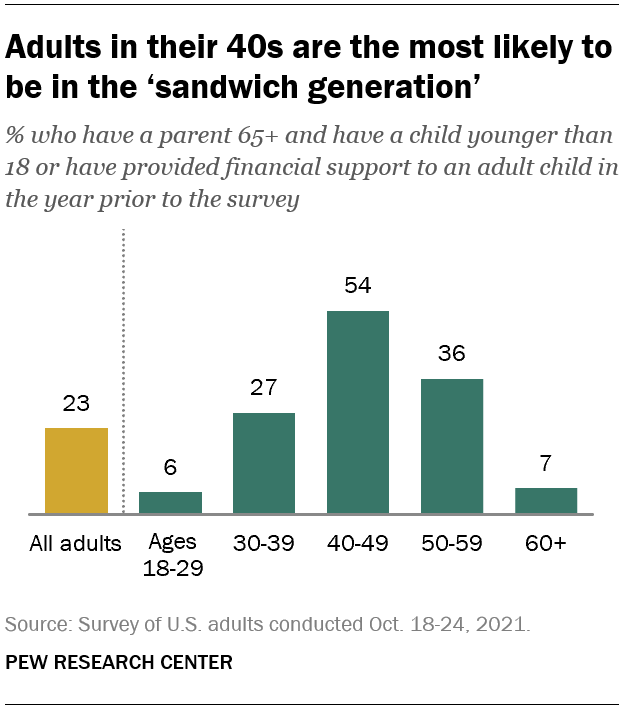The Caregiving Balancing Act: Support Systems for the Sandwich Generation
Are you juggling the dual roles of supporting your children, possibly helping with grandchildren, and assisting aging parents all at once? If so, you’re part of the Sandwich Generation, facing considerable caregiving challenges.
This question resonates with millions who are navigating the daily complexities of providing family assistance to both the younger and older generations in their homes. The journey isn’t easy for most because the path is uncharted.
The Pew Research Center reports that a quarter of U.S. adults (23%) are now part of the “sandwich generation.” Americans in their 40s will most likely be sandwiched between their children and aging parents. 54% of people in their forties have parents over 65 and children younger than 18 that they help financially support.

Robust support systems, such as aging-in-place organizations, can serve as a lifeline, providing families with the tools to manage these sometimes-complicated responsibilities.
In this article, we’ll examine the challenges facing caregivers and the resources available and show how organizations like DSCC understand and work tirelessly to ease the load of caregiving, ensuring seniors receive compassionate care within the comfort and familiarity of their homes.
Are You One Of the Sandwich Generation?
Are you one of the many people caught in the generational squeeze, shouldering the responsibilities of caring for aging parents while supporting your children?
If so, you’re not on the journey alone. You are part of the Sandwich Generation, a growing demographic, quietly shaping the need for care across the nation. Within this circle of caregivers, you’ll find shared experiences and the collective wisdom of those who travel the same path.
The following characteristics indicate you’re part of this vital group, offering validation of your experiences.
You are not alone, and there is support for you.
- Middle-aged adults make up the majority of the sandwich generation. They are most likely from Generation X, between the ages of 40 and 59.
- 23% of adults belong to the sandwich generation.
- 7–10 million adults are long-distance caregivers.
- By 2030, the number of seniors 65 and older will surpass 70 million.
- Adults in their 40s are most likely to be sandwich-generation caregivers. However, according to the Pew Survey, 19% of millennials are younger than 40, and at least 10% are older than 60.
- 54% of sandwich generation caregivers care for a parent 65 or older and a child.
- 1 in 5 sandwich caregivers has a child under 18, has financially supported an adult child, and cared for an aging parent.
If some or all of these characteristics of the Sandwich Generation resonate for you, it’s essential to recognize your courage.
The ability to juggle the challenges of being part of this demographic isn’t just a skill but a testament to your resilience and love. While the challenges are real and demanding, remember that they allow for moments of joy, triumph, and deep connection that only someone in your position can experience.
As we examine some challenges caregivers face, it’s important to know that many support systems are available to partner with you. Embracing the available support can offer practical assistance, strength, and some peace, helping you along your journey as a caregiver in the Sandwich Generation.
Challenges Facing the Sandwich Generation Caregivers
Between managing work, family responsibilities, personal time, relationships, and unexpected day-to-day activities, being a sandwich-generation caregiver is no small feat. It requires grit, courage, a positive mindset, and support.
The strain of being this caregiver can creep up on you. It’s not so much the stress in any one day; it’s the cumulative effort over time that can take its toll.
The caregiving challenges of supporting two generations, parents and children, can show up in different forms —
Burnout — The feelings that come with burnout include guilt and depression, which lead to isolation and loneliness.
Physical health decline — Continuous stress can show up as sleep disturbances, chronic fatigue, and a weakened immune system, which can lead to more illnesses
Emotional exhaustion — Heightened anxiety, irritability, feelings of overwhelm, and strained relationships.
Social withdrawal — Forgoing social engagements, stopping hobbies, and taking less personal time.
Financial pressure — Increased expenses and loss of income if working reduced hours.
The many pressures, to name a few, that weigh upon Sandwich Generation caregivers can be daunting. They often take a toll that extends beyond the emotional to the physical and financial realms of their lives.
The good news is that support systems’ actual value offers hope and assistance in facing these challenges.
Let’s look at some of these support systems designed to bolster the resilience of these caregivers. National resources, local aging-in-place organizations, and other resources can alleviate the burdens associated with caregiving and enrich the lives of the sandwich generation and their families so everyone can thrive.
Support Systems for The Sandwich Generation
Navigating the Sandwich Generation’s caregiver role can feel like a journey through uncharted territory, but an array of support services nationwide offer guidance and aid.
These services provide invaluable tools and assistance from national programs like the AARP Family Caregiving and National Institute on Aging to local community initiatives and online resources such as the National Family Caregiver Alliance.
But amidst these services, aging-in-place organizations shine for their tailored approach to caregiving in local communities. Support organizations like DSCC know their communities, residents, the on-the-ground situation, and complexities, and they exemplify personalized support for seniors and their caregivers.
They offer community-based resources that enable seniors to thrive in the comfort of their own homes, with services ranging from Meals on Wheels, well-being checks, and home repairs to health and wellness programs, community dining events, pet food and assistance, intergenerational activities, and more.
Local, hands-on assistance, such as that provided by aging-in-place organizations, is a testament to immediate support’s power. It bridges the gap between national programs and the everyday needs of caregivers and their families, offering practical solutions and a sense of security.
A Final Thought
It’s important to remember that while the role of a caregiver in the Sandwich Generation may be complex and demanding, a wealth of support is waiting to be called upon.
While national programs provide a strong foundation of resources and knowledge, the heart of support is at home in communities nationwide. Organizations like DSCC embody this homegrown support with a deep understanding of the unique needs of their community’s caregivers and aging-in-place seniors.
With a suite of services designed to ensure comfort, well-being, and community connection, DSCC stands ready to help you navigate the challenges of caregiving with practical and compassionate solutions.
If you or someone you know is on this journey, please consider contacting your local support networks or inviting them to do so. By contacting DSCC or similar organizations
Sources
- Pew Research Center, More than half of Americans in their 40s are ‘sandwiched’ between an aging parent and their children.
- MeetCaregivers, Challenges & Resources For Sandwich Generation Caregivers, January 2023.
- USA Today, Money, What is the ‘sandwich generation’? Many adults struggle with caregiving, bills, and work.
- Forbes, The ‘Sandwich Generation’ Is Financially Taking Care Of Their Parents, Kids, and Themselves. February 2023
More Articles That Might Interest You
Making the Most of February 29th
February 29th comes around every four years in what we call a Leap Year. 2024 is a Leap [...]
Intergenerational Connections: How Businesses Can Champion Their Caregiver Workforce and Aging-in-Place Organizations
Intergenerational Connections: How Businesses Can Champion Their Caregiver Workforce and Aging-in-Place Organizations In today’s workplace, business leaders [...]
Supporting the Sandwich Generation: How Aging-in-Place Organizations Can Lighten the Load
Supporting the Sandwich Generation: How Aging-in-Place Organizations Can Lighten the Load A unique group finds themselves in [...]










